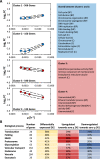Protein production dynamics and physiological adaptation of recombinant Komagataella phaffii at near-zero growth rates
- PMID: 38331812
- PMCID: PMC10851509
- DOI: 10.1186/s12934-024-02314-3
Protein production dynamics and physiological adaptation of recombinant Komagataella phaffii at near-zero growth rates
Abstract
Background: Specific productivity (qP) in yeast correlates with growth, typically peaking at intermediate or maximum specific growth rates (μ). Understanding the factors limiting productivity at extremely low μ might reveal decoupling strategies, but knowledge of production dynamics and physiology in such conditions is scarce. Retentostats, a type of continuous cultivation, enable the well-controlled transition to near-zero µ through the combined retention of biomass and limited substrate supply. Recombinant Komagataella phaffii (syn Pichia pastoris) secreting a bivalent single domain antibody (VHH) was cultivated in aerobic, glucose-limited retentostats to investigate recombinant protein production dynamics and broaden our understanding of relevant physiological adaptations at near-zero growth conditions.
Results: By the end of the retentostat cultivation, doubling times of approx. two months were reached, corresponding to µ = 0.00047 h-1. Despite these extremely slow growth rates, the proportion of viable cells remained high, and de novo synthesis and secretion of the VHH were observed. The average qP at the end of the retentostat was estimated at 0.019 mg g-1 h-1. Transcriptomics indicated that genes involved in protein biosynthesis were only moderately downregulated towards zero growth, while secretory pathway genes were mostly regulated in a manner seemingly detrimental to protein secretion. Adaptation to near-zero growth conditions of recombinant K. phaffii resulted in significant changes in the total protein, RNA, DNA and lipid content, and lipidomics revealed a complex adaptation pattern regarding the lipid class composition. The higher abundance of storage lipids as well as storage carbohydrates indicates that the cells are preparing for long-term survival.
Conclusions: In conclusion, retentostat cultivation proved to be a valuable tool to identify potential engineering targets to decouple growth and protein production and gain important insights into the physiological adaptation of K. phaffii to near-zero growth conditions.
© 2024. The Author(s).
Conflict of interest statement
The authors declare no competing interests.
Figures




Similar articles
-
Pichia pastoris Exhibits High Viability and a Low Maintenance Energy Requirement at Near-Zero Specific Growth Rates.Appl Environ Microbiol. 2016 Jul 15;82(15):4570-4583. doi: 10.1128/AEM.00638-16. Print 2016 Aug 1. Appl Environ Microbiol. 2016. PMID: 27208115 Free PMC article.
-
Production and secretion dynamics of prokaryotic Penicillin G acylase in Pichia pastoris.Appl Microbiol Biotechnol. 2020 Jul;104(13):5787-5800. doi: 10.1007/s00253-020-10669-x. Epub 2020 May 18. Appl Microbiol Biotechnol. 2020. PMID: 32424437 Free PMC article.
-
Quantitative Physiology of Non-Energy-Limited Retentostat Cultures of Saccharomyces cerevisiae at Near-Zero Specific Growth Rates.Appl Environ Microbiol. 2019 Oct 1;85(20):e01161-19. doi: 10.1128/AEM.01161-19. Print 2019 Oct 15. Appl Environ Microbiol. 2019. PMID: 31375494 Free PMC article.
-
Komagataella phaffii (Pichia pastoris) as a Powerful Yeast Expression System for Biologics Production.Front Biosci (Elite Ed). 2024 Jun 12;16(2):19. doi: 10.31083/j.fbe1602019. Front Biosci (Elite Ed). 2024. PMID: 38939917 Review.
-
A Systematic Review of the Potential of Pichia pastoris (Komagataella phaffii) as an Alternative Host for Biologics Production.Mol Biotechnol. 2024 Jul;66(7):1621-1639. doi: 10.1007/s12033-023-00803-1. Epub 2023 Jul 3. Mol Biotechnol. 2024. PMID: 37400712
Cited by
-
Characterising the metabolic rewiring of extremely slow growing Komagataella phaffii.Microb Biotechnol. 2024 Jan;17(1):e14386. doi: 10.1111/1751-7915.14386. Epub 2024 Jan 11. Microb Biotechnol. 2024. PMID: 38206275 Free PMC article.
-
Identification and functional analysis of growth rate associated long non-coding RNAs in Komagataella phaffii.Comput Struct Biotechnol J. 2025 Apr 22;27:1693-1705. doi: 10.1016/j.csbj.2025.04.028. eCollection 2025. Comput Struct Biotechnol J. 2025. PMID: 40352477 Free PMC article.
-
Transferability of bioprocessing modes for recombinant protease production: from fed-batch to continuous cultivation with Bacillus licheniformis.BMC Biotechnol. 2025 Jan 31;25(1):13. doi: 10.1186/s12896-025-00947-9. BMC Biotechnol. 2025. PMID: 39891175 Free PMC article.
-
Impact of Oxygen Availability on the Organelle-Specific Redox Potentials and Stress in Recombinant Protein Producing Komagataella phaffii.Microb Biotechnol. 2025 Feb;18(2):e70106. doi: 10.1111/1751-7915.70106. Microb Biotechnol. 2025. PMID: 39937160 Free PMC article.
References
MeSH terms
Substances
Supplementary concepts
Grants and funding
LinkOut - more resources
Full Text Sources
Research Materials
Miscellaneous

